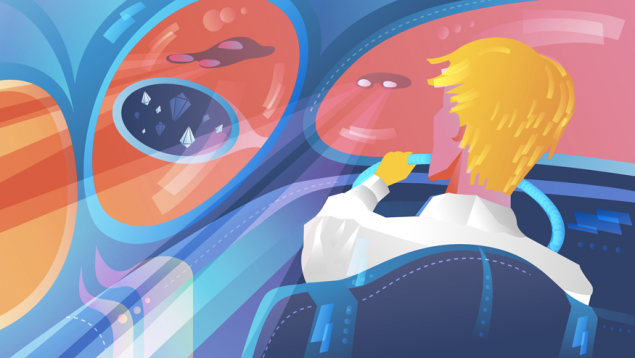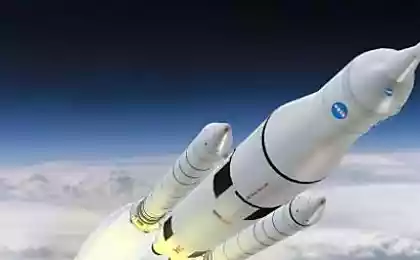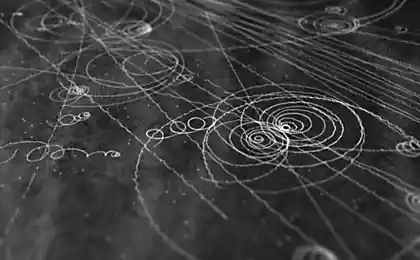686
10 facts about antimatter, which You might not know

Antimatter has long been a subject of science fiction. In the book and movie "Angels and demons" Professor Langdon tries to save the Vatican from a bomb of antimatter. The space ship "enterprise" from "Star trek" uses the engine on the basis of the annihilating antimatter to travel faster than the speed of light. But antimatter is also a subject of our reality. Particles of antimatter are almost identical to the material, with the exception that carry the opposite charge and spin. When antimatter meets matter, they annihilate into energy, and this is not fiction.
Although the bomb is made of antimatter and ships on the basis of the same fuel does not seem possible in practice, there are many facts about antimatter that will surprise you or will allow you to refresh your memory of what you already knew.
1. Antimatter had to destroy all matter in the Universe after the Big Взрыва

According to the theory, the Big Bang was created matter and antimatter in equal amounts. When they meet there is a mutual destruction, annihilation, and only pure energy. Based on this, we should not exist.
But we do exist. And as far as I know physics, it's because for every billion pairs of matter-antimatter was one extra particle of matter. Physicists are struggling to explain this asymmetry.
2. Antimatter is closer to you than you думаете

Small amounts of antimatter are constantly rain down upon the Earth in the form of cosmic rays, energetic particles from space. These antimatter particles reach our atmosphere with a level from one to hundreds per square meter. Scientists also have svidetelstvom that antimatter is born during a thunderstorm.
There are other sources of antimatter, which are closer to us. Bananas, for example, produce antimatter, emitting one positron — antimesenteric equivalent electron — approximately every 75 minutes. This is because bananas contain a small amount of potassium-40, a naturally occurring isotope of potassium. The decay of potassium-40 sometimes becomes a positron.
Our bodies also contain potassium-40, and hence you emit positrons. Anti-matter instantly annihilates upon contact with matter, so these antimatter particles don't live very long.
3. People managed to create quite a bit антиматерии

Annihilation of antimatter and matter has the potential of releasing huge amounts of energy. Gram of antimatter can produce an explosion the size of a nuclear bomb. However, people produced not so much antimatter, so there is nothing to fear.
All the antiprotons created in a particle accelerator Tevatron at Fermilab, will hardly reach 15 nanograms. At CERN to date has produced only about 1 nanograms. At DESY in Germany — no more than 2 nanograms of positrons.
If all of the antimatter created by the people, annihilated instantly, her energy is not even enough to boil a Cup of tea.
The problem lies in the efficiency and cost of production and storage of antimatter. Create 1 gram of antimatter requires about 25 million billion kilowatt-hours of energy and is above a million billion dollars. It is no wonder that antimatter is sometimes included in the list of ten most expensive substances in the world.
4. There is such a thing as a trap for антиматерии

For the study of the antimatter you need to prevent its annihilation with matter. Scientists have found several ways to do it.
Charged particles of antimatter like positrons and antiprotons can be stored in so-called penning trap. They look like tiny particle accelerators. Inside particles moving in a spiral until the magnetic and electric fields to keep them from colliding with the walls of the trap.
However, the penning trap does not work for neutral particles like hydrogen. Because they have no charge, these particles cannot be confined to electrical fields. They are held in Ioffe traps that work, creating a region of space where the magnetic field becomes larger in all directions. Particles of antimatter are stuck in a region with the weakest magnetic field.
The Earth's magnetic field can act as traps antimatter. Antiprotons found in certain areas around the Earth — radiation van Allen belts.
5. Antimatter may fall (in the literal sense of the word)

Particles of matter and antimatter have the same mass, but differ in properties like electric charge and spin. The standard model predicts that gravity should act the same on matter and antimatter, however, it remains to be seen for sure. Experiments like AEGIS, GBAR ALPHA and working on it.
To observe gravitational effect on the example of antimatter is not as easy as to look at falling from the tree an Apple. These experiments require holding antimatter in a trap or slowing it by cooling to temperatures just above absolute zero. And since gravity is the weakest of the fundamental forces, physicists have to use a neutral particle of antimatter in these experiments to prevent interactions with more powerful force of electricity.
6. Antimatter is examined in inhibitors частиц

You've heard about particle accelerators, and retarders particles heard? CERN is a machine called the Antiproton Decelerator, the ring is trapped and slow down antiprotons to study their properties and behavior.
In ring particle accelerators like the Large hadron Collider, the particles receive an energy boost every time complete the circle. Inhibitors work in the opposite way: instead of disperse particles, push them in the opposite direction.
7. Neutrinos can be their own античастицами

A particle of matter and its antimatter partner carry opposite charges, which makes it easy to distinguish between them. Neutrinos, nearly massless particles that rarely interact with matter, have no charge. Scientists believe that they can be Majorana particle, a hypothetical class of particles which are their own antiparticles.
Projects like the Majorana Demonstrator, and EXO-200 is aimed at determining whether neutrinos are Majorana particles, observing the behavior of the so-called neutrinoless double beta decay.
Some radioactive nuclei decay simultaneously, emitting two electrons and two neutrinos. If neutrinos were their own antiparticles, they would be annihilated after a double dissolution, and scientists would be left to observe only electrons.
Search for Majorana neutrinos can help to explain how there is an asymmetry of matter-antimatter. Physics suggest that Majorana neutrinos can be either heavy or light. Light exist in our time, and the heavy existed immediately after the Big Bang. Heavy Majorana neutrinos decayed asymmetrically, which led to the emergence of a tiny amount of matter that filled our universe.
8. Antimatter is used in медицине

PET, PET (positron emission tomography) uses positrons to produce images of the body in high resolution. Positron emitting radioactive isotopes (such as those we found in bananas) are attached to chemical substances like glucose, which is present in the body. They are injected into the bloodstream, where decay naturally, emitting positrons. Those, in turn, meet with the electrons of the body and annihilate. The annihilation produces gamma rays, which are used to construct the image.
Scientists of the ACE project at CERN study antimatter as a potential candidate for cancer treatment. Doctors have found that can direct tumor particle beams, emit its energy only after safely pass through healthy tissue. The use of antiprotons will add an extra burst of energy. This technique has been found to be effective for the treatment of hamsters, but that's on humans until tested.
9. Antimatter may be hiding in космосе

One of the ways in which scientists try to solve the problem of the asymmetry of matter-antimatter, is the search for antimatter left over after the Big Bang.
Alpha Magnetic Spectrometer (AMS) is a particle detector located on the International space station and searches for such particles. AMS contains magnetic fields that bend the path of cosmic particles and separating matter from antimatter. His detectors need to detect and identify such particles as it passes.
Collision of cosmic rays typically produce positrons and antiprotons, but the probability of the creation of the atom anthelia remains extremely low because of the huge amount of energy that is required for this process. This means that the observation of at least one nucleolus anthelia is powerful evidence of the existence of giant amounts of antimatter elsewhere in the Universe.
10. People actually study how to equip the spacecraft with fuel on антивеществе

Quite a bit of antimatter can produce an enormous amount of energy, which makes it a popular fuel for futuristic vehicles in science fiction.
The movement of the rocket on the antimatter is hypothetically possible; the main limitation is collecting enough antimatter that it can be done.
There is still no technology for mass production or harvesting of antimatter in amounts required for such application. However, scientists are working on the simulation of such movement and storage of the antimatter. One day, if we can find a way to produce large amounts of antimatter, their research could help interstellar travel to become real.published
P. S. And remember, only by changing their consumption — together we change the world! ©
Source: hi-news.ru























